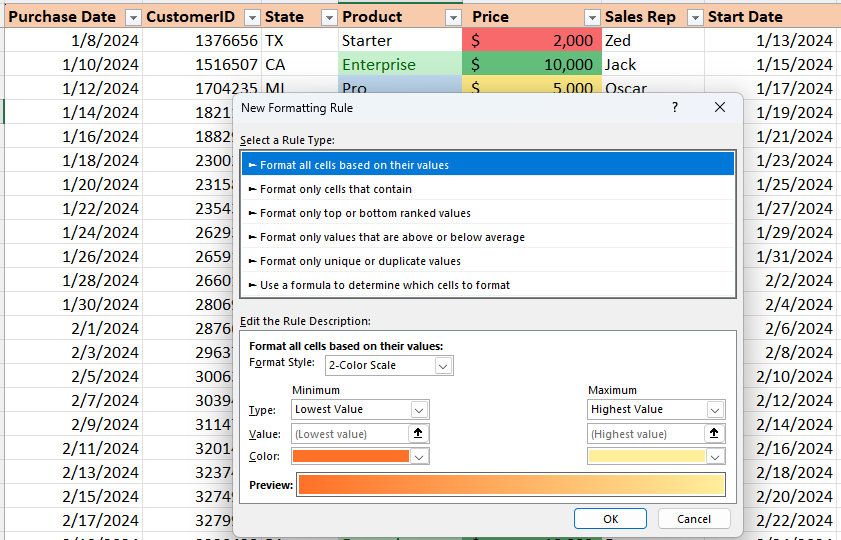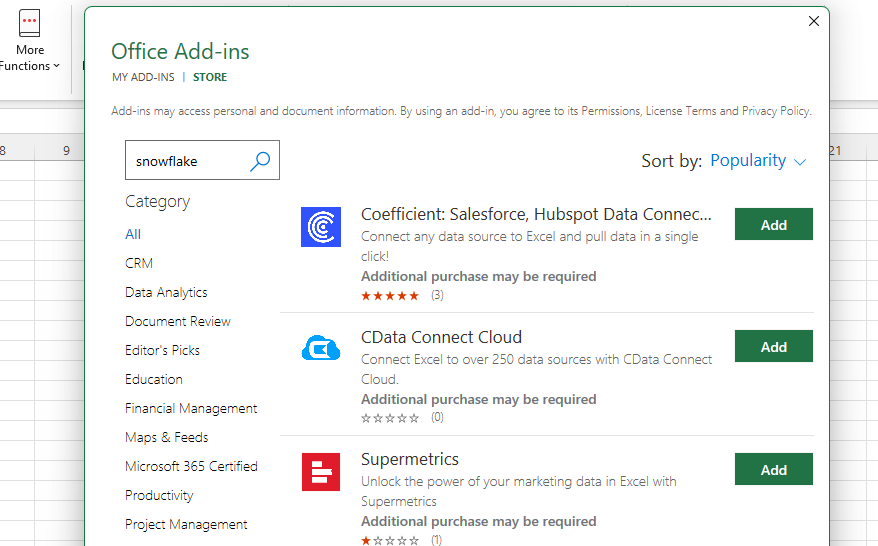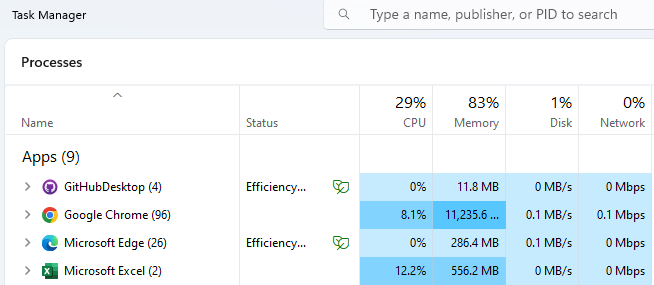Excel is a very powerful tool, but users often encounter performance issues as their spreadsheets grow larger or become more complex. Excel can lag, freeze, or even crash, affecting productivity and introducing data governance issues. Understanding why Excel slows down is key to improving its performance and making your workflow more efficient.
In the post below, we provide common reasons why Excel is slow, ways to make Excel faster, and how to unfreeze Excel. If you are looking for a quick solution, try Row Zero, a next-gen spreadsheet built for big data and speed that can handle massive billion row datasets (1,000x Excel's limit). Continue reading or use the table of contents to skip to specific sections.
- Top 10 Reasons Why Excel is Slow (with solutions)
- How to Unfreeze Excel and Recover Unsaved Work
- Minimum Requirements for Big Excel Workloads
- Conclusion
Top 10 Reasons Why Excel is Slow (with solutions).
There are a number of reasons why your Excel workbook is slow to respond, frozen, or slow to open. Skip to a specific number below or continue for the full list.
- Your data is too big for Excel
- Complex or volatile Excel functions and formulas
- Using too many formulas
- Excessive formatting and conditional formatting
- Connectors, add-ins, plugins, and external links
- Unused rows and columns or full column references
- Too many worksheets
- Your data changes and requires frequent recalculation
- Automatic calculations
- Your computer does not have enough memory
1. Your data is too big for Excel
A common reason why Excel is unresponsive or very slow is that your dataset or file is too large for Excel. Excel has a row limit of 1,048,576 rows and will slow down well before this limit if your dataset has lots of columns, formulas, or pivot tables. 
Solutions: The simplest solution is to use a more powerful spreadsheet. Row Zero is a next-gen spreadsheet built for big data. It works like Excel but can handle billion row datasets (1000x Excel's row limit). Row Zero is free to try and is a good Excel alternative for big data users.
Other Solutions:
- Reduce your file size by removing unnecessary data, splitting into multiple files, converting data ranges to tables, or using Excel's Power Query to process data externally.
- Upgrade to 64-bit Excel: If you're still using the 32-bit version, upgrade to 64-bit for access to more RAM and better performance with large workbooks. Note 64-bit Excel still has the same row limits but will perform better under those limits.
2. Complex or volatile Excel functions and formulas
Certain Excel functions are more likely to slow down your workbook. Volatile functions are those that automatically recalculate every time any change is made to the worksheet, regardless of whether the change affects the cells involved in the formula. This can make Excel lag or slow severely, especially in large datasets or complex calculations. Some of the most volatile functions in Excel are NOW, TODAY, RAND, OFFSET, and INDIRECT. Excessive use of array formulas, VLOOKUP, XLOOKUP, SUMIFS, COUNTIFS, etc. over large ranges will also slow Excel performance.
Solutions:
- Only use volatile functions when absolutely necessary. Consider alternatives like using a timestamp with a manual trigger rather than NOW() or TODAY().
- Use pivot tables instead of lots of formulas. Pivot tables are much more efficient than COUNTIFS or SUMIFS for summarizing large datasets.
- Use INDEX-MATCH instead of VLOOKUP. It's generally faster for large datasets
- Use array formulas only when necessary. Avoid applying them to unnecessarily large ranges and consider breaking array formulas into smaller, more manageable parts.
- Switch to manual calculations by going to Formulas > Calculation Options > Manual. This way, you control when recalculations occur. Hit F9 to recalculate manually.
3. Using too many formulas
In addition to using complex formulas, using a large number of formulas over large ranges in Excel can slow down workbooks or cause Excel to freeze. Excel recalculates formulas every time an update is made, so more formulas will slow Excel performance.
Solutions:
- Replace formulas with values where possible. If you have formulas that were calculated once and don't need to change, you can select the cell range, copy, and paste values to prevent Excel from having to run these calculations over and over unnecessarily.
- Use pivot tables instead of lots of formulas. A few pivot tables can replace a lot of Excel formulas.
- Switch to manual calculations by going to Formulas > Calculation Options > Manual. You can then manually recalculate by hitting F9.
- Use faster formulas where possible. Here are some examples:
- Use INDEX-MATCH vs VLOOKUP, especially in large datasets.
- Use SUMPRODUCT instead of complex array formulas or for multiple conditions.
- Use INDEX and tables instead of volatile functions like INDIRECT and OFFSET
- Use CHOOSE vs nested IF statements
- Use AGGREGATE vs array formulas for large data
- Use XLOOKUP vs VLOOKUP or HLOOKUP
- Use TEXTJOIN vs CONCATENATE
- Use helper columns vs array formulas
- Use IFERROR instead of combining IF and ISERROR
4. Excessive formatting and conditional formatting
Overuse of cell styling, borders, fonts, and colors can slow Excel down. In particular, excessive use of conditional formatting can create rendering issues. 
Solutions:
- Clear unnecessary formatting by using the "Clear Formats" option under Home > Editing.
- Minimize the use of conditional formatting by removing rules that aren’t critical or by applying formatting to smaller ranges of data.
5. Connectors, add-ins, plugins, and external links
It's increasingly common to use connectors and add-ins to connect Excel to data warehouses, SaaS data platforms (e.g. Salesforce, Quickbooks), BI tools (e.g. PowerBI, Power Pivot) or add-ins that enhance data analysis in Excel. However, connecting Excel files to external data sources or workbooks can introduce lag when recalculating or updating links. Third-party add-ins can cause Excel to run slower if they are poorly optimized or conflicting. 
Solutions:
- Minimize external links and consolidate data into a single workbook where possible.
- Disable unnecessary add-ins by navigating to File > Options > Add-ins and deselecting what isn’t needed.
- Use an alternative spreadsheet like Row Zero, which has built-ins to common data sources (e.g. Postgres, Snowflake, Datbricks, S3, etc.), native python functionality, and can handle much larger workbooks (1,000x Excel's limits).
6. Unused rows and columns or full column references
One potential issue with your Excel file size is if your workbook has a lot of unused rows and columns. Excel processes entire columns and rows, even if they are empty. In particular, full column references can slow performance. When Excel sees "A:A", it checks the entire column even if most of the column is blank.
Solution: Delete or hide unused rows and columns. You can also change full column references to cell ranges (e.g. A1:C3000 instead of A:C). This can reduce the file size and speed up Excel’s response time.
7. Too many worksheets
Having numerous worksheets open in a single workbook can hog system resources and make Excel lag unnecessarily.
Solution: Break up the workbook into smaller files, or archive older, unused worksheets to a separate file.
8. Your data changes and requires frequent recalculation
If your source data changes frequently and is referenced in a large amount of formulas and calculations, this can make Excel extremely slow. This can also make Excel freeze or unresponsive since the recalculation keeps going. For example, Excel struggles to work with high volumes of real-time data like stock quotes or live, streaming data.
Solutions:
- If possible, try to really simplify or isolate anything referencing changing source data.
- Switch to manual calculations by going to Formulas > Calculation Options > Manual. Hit F9 to recalculate manually.
- You may need to switch to a more powerful spreadsheet like Row Zero or a BI tool like Power BI or Tableau that is built for real-time data and sits on top of your source data.
9. Automatic calculations
As mentioned above, Excel is set to automatically recalculate whenever changes are made. If you're running into the issues above like data size limits and complex formulas, automatic calculations are going to be a recurring issue that make Excel run slow or freeze.
Solution: Switch to manual calculations by going to Formulas > Calculation Options > Manual. This way, you control when recalculations occur. Hit F9 to recalculate manually. 
10. Your computer does not have enough memory
Excel relies heavily on RAM for processing large datasets. If your computer has insufficient memory (RAM) or processor speed, it may make Excel unresponsive or slow to work with. Keep in mind, other applications, like your web browser and other programs, are also using RAM, which leaves less to allocate to Excel if you have a lot of applications open. Excel also has its own memory limits. The 32-bit version of Excel has a memory limit of 2GB of RAM. View the minimum requirement for intensive Excel workloads.
Solutions:
- Close unnecessary applications: Running other memory-intensive applications while using Excel can impact performance, especially if you are working with large files.
- Monitor resource usage: Use Task Manager (Windows) or Activity Monitor (macOS) to check how much memory and CPU Excel is consuming. If Excel consistently maxes out your CPU or RAM, consider upgrading your system.
- Upgrade your machine - View recommended specs.
- Use a cloud spreadsheet like Row Zero - Row Zero runs in the cloud and is not hamstrung by the hardware on a user's computer.
How to Unfreeze Excel and Recover Unsaved Work
As mentioned above, Excel freezing can be caused by several factors including hardware limitations, large file sizes, add-ins, and automatic recalculations. By disabling unnecessary features, optimizing Excel settings, or upgrading your hardware, you can significantly reduce the chances of Excel freezing and ensure smoother operation.
If Excel is frozen or unresponsive, there are several steps you can take to unfreeze Excel and prevent future occurrences. Here are a few methods to try:
1. Wait for Excel to respond
Sometimes Excel is temporarily unresponsive because it's processing a large operation. Give it a few moments, especially if you were running a complex formula, macro, or large data set. If it is a temporary freeze, Excel might start responding again after a brief pause.
2. Force quit Excel
When Excel is frozen or unresponsive, you can force Excel to close. This will cause you to lose any unsaved work, but it will unfreeze Excel.

Windows:
- Press Ctrl + Alt + Delete and select Task Manager.
- Find Microsoft Excel in the list, right-click, and select End Task.
Mac:
- Press Command + Option + Esc.
- Select Excel from the list and click Force Quit.
3. Recover unsaved work after an Excel crash
If Excel crashes and closes, you can recover unsaved files using Excel's AutoRecover feature.
- Open Excel, and if AutoRecover is enabled, a Document Recovery pane should appear on the left. You can open the latest autosaved version from there.
- You can also check saved recovery files in File > Info > Manage Workbook > Recover Unsaved Workbooks.
4. How to prevent Excel from freezing
In addition to the steps above to fix common reason why Excel is slow or frozen, there are a few additional best practices to prevent Excel from crashing:
- Update Excel: Make sure your version of Excel is up to date. Sometimes Excel freezing issues are caused by bugs that have been fixed in newer updates. How to update Excel: go to File > Account and click Update Options and then select Update Now.
- Repair Office Installation: If the Excel continues to freeze, try repairing the Office installation. This can resolve any corrupted files or configurations causing Excel to freeze. In Windows:
- Open Control Panel.
- Go to Programs > Programs and Features.
- Select Microsoft Office and click Change.
- Choose Quick Repair or Online Repair, and follow the prompts. For Macs, you can reinstall Office by removing the application and downloading the latest version from your Office 365 account.
- Free Up System Resources: Ensure your computer has enough resources (memory, CPU, etc.) to run Excel. Close unnecessary programs and tasks that may be using up system resources. You can monitor usage with Task Manager on Windows machines or Activity Monitor on Macs.
Minimum Requirements for Big Excel Workloads
1. Memory (RAM):
- Minimum: 8 GB of RAM.
- Recommended: 16 GB or more.
- Why: Excel relies heavily on RAM for processing large datasets. With 16 GB or more, your system will be able to handle larger Excel files (hundreds of thousands of rows) without experiencing slowdowns or memory crashes.
2. CPU (Processor):
- Minimum: Quad-core processor (e.g., Intel Core i5 or equivalent).
- Recommended: Intel Core i7 or i9 (or AMD Ryzen 7/9) with at least 6 or 8 cores.
- Why: Excel is optimized for multi-threading, so a processor with more cores will handle complex calculations and multi-tasking much better. Higher clock speeds (3 GHz or more) also improve overall performance when working with large, formula-heavy spreadsheets.
3. Storage (SSD vs. HDD):
- Recommended: Solid State Drive (SSD), at least 256 GB.
- Why: Excel benefits significantly from faster read/write speeds. SSDs drastically reduce file load times, especially for large files, compared to traditional hard drives (HDDs).
4. Excel Version:
- 64-bit Version of Excel: Use the 64-bit version of Excel if you are working with large files (e.g., more than 300,000 rows of data). The 32-bit version is limited to 2 GB of memory, while the 64-bit version can utilize as much memory as your system has available.
5. Operating System:
- Windows 10 or 11 (64-bit): Windows tends to be the best platform for Excel, particularly for advanced tasks and features like Power Pivot and VBA macros, which can be slower or unsupported in macOS.
- Why: Excel is optimized for Windows, and the 64-bit version can take full advantage of your computer’s memory and processor.
Conclusion
As datasets grow larger and the proliferation of add-ins and connectors increases, it's increasingly common for users to hit Excel performance limits. It's frustrating when Excel is very slow or when Excel freezes and becomes unresponsive. While there are a lot of reasons why excel is slow there are also a lot of ways to make Excel faster. The most important thing is to be aware of Excel's limits and plan accordingly. If you ultimately need to work with larger datasets, need to connect directly to your data source, or are building complex models you may need to switch to a BI tool or a more powerful spreadsheet that is better than Excel for these tasks. Row Zero is the world's fastest and most powerful spreadsheet and is built for big data users, complex models, and enterprise security. You can try Row Zero for free.